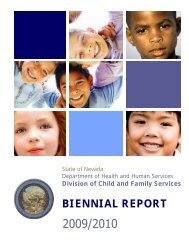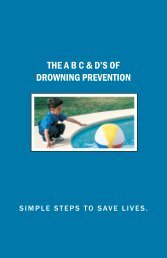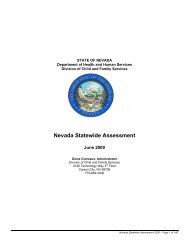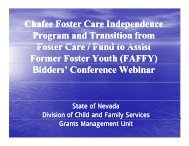STATE OF NEVADA - Division of Child and Family Services
STATE OF NEVADA - Division of Child and Family Services
STATE OF NEVADA - Division of Child and Family Services
Create successful ePaper yourself
Turn your PDF publications into a flip-book with our unique Google optimized e-Paper software.
Referrals for Developmental Assessments<br />
Recommendation 3: Caseworkers need to comply with the <strong>Child</strong> Abuse Prevention <strong>and</strong><br />
Treatment Act (CAPTA) requirement for developmental assessments <strong>of</strong> young children: Within<br />
two working days <strong>of</strong> identifying a child age three or under with substantiated abuse <strong>and</strong> neglect<br />
or a positive drug screen, caseworkers must refer the child for a developmental assessment from<br />
Nevada Early Intervention <strong>Services</strong> (NEIS). Additionally, caseworkers need to follow through<br />
on the referrals by tracking outcomes in the new service referral window in UNITY.<br />
Discussion: The primary findings from the CRP’s 2009 targeted case reviews, focused on<br />
referrals for developmental assessments, are as follows:<br />
<br />
<br />
Clark County: Out <strong>of</strong> 20 cases reviewed, there were 11 cases that met the CAPTA<br />
criteria where no referrals were made, <strong>and</strong> 9 cases where referrals were made. This<br />
yields a referral rate <strong>of</strong> 55%. Many <strong>of</strong> the referrals did not meet the 2-day time<br />
frame.<br />
Rural Region: Out <strong>of</strong> the 6 cases reviewed, there were 3 cases that met the CAPTA<br />
criteria where no referrals were made, <strong>and</strong> 3 cases where referrals were made. This<br />
yields a referral rate <strong>of</strong> 50%.<br />
These referral rates are similar to the rate estimated by the CJA Task Force in its review <strong>of</strong><br />
DCFS data on referrals compared with NEIS data on assessments, which showed that about half<br />
<strong>of</strong> cases that meet the CAPTA criteria result in completed referrals. Unfortunately, it is difficult<br />
to determine whether this is a practice concern <strong>and</strong> caseworkers are not making necessary<br />
referrals for assessments, or if this is a documentation problem <strong>and</strong> referrals are not being<br />
tracked well through UNITY. This underscores the importance <strong>of</strong> Recommendation 2 above,<br />
because external case reviewers such as the CRP cannot make a conclusive distinction between<br />
practice problems <strong>and</strong> documentation problems in this area <strong>of</strong> review. The Panel believes it is<br />
likely that both are contributing factors to the low referral rate.<br />
Either way, a referral rate <strong>of</strong> approximately 50% is not in substantial compliance with the<br />
CAPTA requirement. The Panel underst<strong>and</strong>s that NEIS faces funding shortages in terms <strong>of</strong> its<br />
ability to respond to referrals from DCFS. However, the CRP believes that a step-at-a-time<br />
approach should be taken, such that CPS agencies <strong>and</strong> staff are trained <strong>and</strong> supervised<br />
appropriately to comply with the CAPTA m<strong>and</strong>ate <strong>and</strong> to complete referrals where required.<br />
Once correct referrals are being made in compliance with the law, then the CRP or other external<br />
stakeholders may choose to further evaluate NEIS’ service capacity to respond to these referrals.<br />
CRP ANNUAL REPORT 2009 9
















